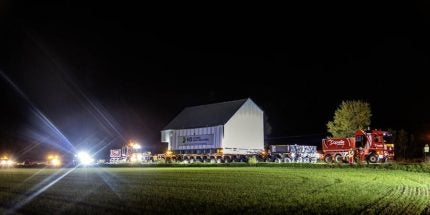
The fourth and last vacuum vessel sector supplied to the International Thermonuclear Experimental Reactor (ITER), under construction in France, has arrived at the site. In 2008 the Korean Domestic Agency, signed the Procurement Arrangement for two vacuum vessel sectors for the ITER tokamak and later agreed to supply another two sectors under direct ITER Organisation contract through a Delegation Agreement.
The four Korean vacuum vessel sectors were manufactured by Hyundai Heavy Industries at the company’s giant shipyard in Ulsan, on the eastern coast of the peninsula. Work on the first of the four massive components began in October 2012 with high-pressure water jet cutting to shape 2 x 6 metre, 60-millimetre-thick steel plates. Press forming followed, then heat treatment to release the tension inside the metal, machining, welding, drilling (hundreds of holes, at 11 hours of drilling per hole) and eventually assembling and welding the four segments and set of ports that form a finalized vacuum vessel sector.
The fabrication of the vacuum vessel sectors is shared between F4E, ITER Organisation’s European domestic agency (five sectors) and the Korean Domestic Agency (four sectors). ITER’s vacuum vessel (plasma chamber), with an interior volume of 1,400 cubic metres, houses the fusion reactions and is the first safety containment barrier. It will comprise nine wedge-shaped steel sectors each more than 14 metres high and weighing 440 tonnes.
A first sector (#6) from Korea came off the production line in April 2020 and was delivered to ITER the following August. Vacuum vessel sector 6 is at the centre of the assembly and is associated thermal shielding. The last sector (#1) began its journey by sea 24 August and arrived at ITER on 8 November.
The ITER vacuum vessel, once assembled, will have an outer diameter of 19.4 metres, a height of 11.4 metres, and weigh approximately 5,200 tonnes. Installation of in-vessel components such as the blanket and the divertor will increase the weight to 8,500 tonnes.
Further reading: ITER fusion project sets new 2035 start date






